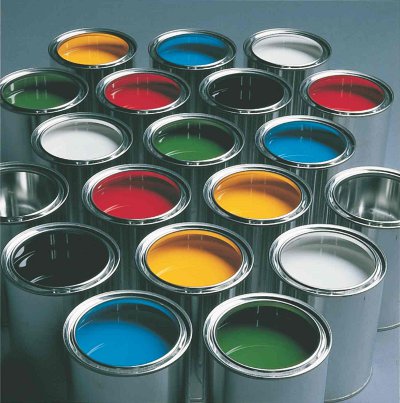.jpg) Most of the world's ethanol is produced by fermentation of crops (93%) with synthetic ethanol (7%) being produced by direct hydration of ethene.
Most of the world's ethanol is produced by fermentation of crops (93%) with synthetic ethanol (7%) being produced by direct hydration of ethene.
Uses of ethanol
The fermentation of plant material (for example, barley and rice) is the route by which alcoholic drinks (e.g. beer, whiskey, gin and vodka) are produced. It is also how bioethanol for biofuels is produced.
Of the uses of bioethanol, easily the most important is as a fuel for cars. However an increasing one is in the manufacture of ethene as a route to poly(ethene). The other main uses of ethanol as a chemical intermediate are for:
It is also used as a solvent in the manufacture of cosmetics, pharmaceuticals, detergents, inks and coatings.

Figure 1 Ethanol is one of the starting materials for production of ethyl
propenoate, a co-monomer for polymers used in emulsion paints.
By kind permission of AkzoNobel.
Annual production of ethanol
| World | 850 000 tonnes |
| Europe | 470 000 tonnes |
These figures relate to synthetic alcohol (i.e. does not include alcohol produced biosynthetically, bioethanol).
The amount of bioethanol produced is enormous in comparison1. In 2015, 25.7 billion gallons (ca 80 million tonnes) were produced. Of these, 14.6 billion gallons (ca 44 million tonnes) were produced in the United States, mainly from corn, 7.1 billion gallons (ca 21 million tonnes) in Brazil, mainly from sugar. Europe produced significantly less, 1,4 billion gallons (ca 1 million tonnes).
1. Renewable Fuels Association, 2016
Manufacture of ethanol
Ethanol is manufactured by the direct catalytic hydration of ethene in the presence of steam, using phosphoric acid adsorbed on the surface of a solid (silica)
as a catalyst in a fixed bed reactor. The reaction is reversible and exothermic:
.jpg)
From the equilibrium equation, it can be seen that conversion of the feedstock to ethanol is favoured by low temperature, high pressure and high steam concentration.
To achieve acceptable reaction rates, a temperature of ca 500 K is used in the presence of the catalyst. Increasing the pressure pushes the reaction to the product side but also causes polymerization of the ethene. Higher pressures also mean increased capital and operating costs. In practice, the process is generally operated under a pressure of 60-70 atm.
|
Higher ethene conversion can be obtained using an excess of water (steam). But at high pressures the catalyst takes up water, its activity drops and it becomes diluted, draining away from the catalyst support. A mole ratio of water : ethene around 0.6 : 1 is commonly used.
Great care is exercised to minimise the emissions of ethanol from the plant, together with the small amounts of by-products that are produced, principally ethanal (acetaldehyde) and diethyl ether.
Considerable work is being done to improve the catalyst so that the temperature of the furnace can be reduced. This means that less fuel will be used to heat the furnace, and the position of equilibrium will be 'shifted' to favour the product.
With the above conditions, around 5% conversion per pass is obtained. To obtain the 95% yield achieved, unreacted ethene is separated from the liquid products and recycled.
The product contains a high proportion of water and is distilled to produce a 95% (w/w) solution of ethanol.
Production of pure ethanol
(i) Distillation
Further distillation of the 95% solution of ethanol in water does not improve the purity as an azeotrope (constant boiling mixture) is produced. This can be overcome by adding a third compound (e.g. benzene) which 'breaks up' the azeotrope but this involves more distillations and consequently more energy.
(ii) Pressure swing adsorption
A zeolite molecular sieve is being increasingly employed to remove the water to produce pure ethanol by a process known as pressure swimg adsorption.
The mixture of ethanol and water is passed through a column containing pellets of a molecular sieve of 3 A (i.e. the pores have diameters of 3 angstroms, 3x10-10 m or 0.3 nm).
.jpg)
Figure 3 Purification of ethanol by pressure swing adsorption using a zeolite.
Although both ethanol and water are polar, only water molecules (diameter 0.28 nm) are able to pass through the pores as the diameter of ethanol molecules is too large (0.44 nm). Thus the water molecules enter through the pores and are trapped in the cages of the zeolite. The ethanol passes through the column and is collected.
In one method, which is usually used, the ethanol-water mixture is passed through the column in the gas phase at about 420 K, under pressure (4 atm) (Figures 3 and 4). The water vapour passes through the pores and is adsorbed, as a liquid, in the cages.
|
The term 'swing' is used because two columns are used in parallel. In Figure 3 the left hand column is being used to dry ethanol while the other, right hand one, is being used to regenerate the zeolite.
In the second method, the liquid solution of ethanol and water is passed through a column of the zeolite and the pure ethanol is collected. After several hours, the bed is drained and heated to over 500 K using a stream of heated nitrogen. The water is expelled. This technique is called thermal (or temperature) swing adsorption.
Date last amended: 27th October 2016

.jpg)
.jpg)